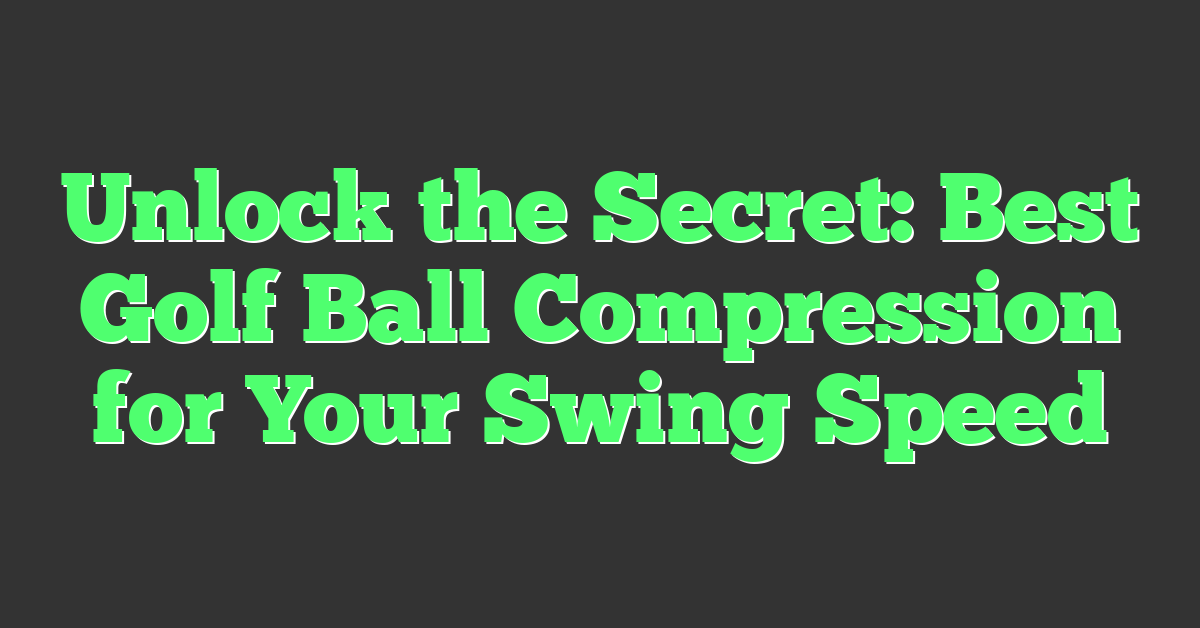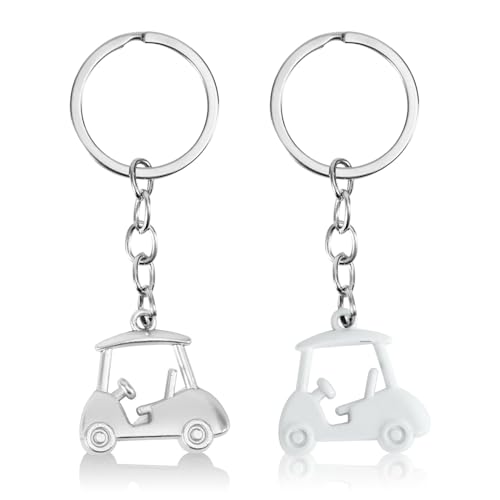Ever wondered why some golf balls feel like a marshmallow off your clubface while others are as unyielding as a rock? That’s all about compression, folks. It’s not just a buzzword; it’s the secret sauce that can add yards to your drive or finesse to your short game.

You’re about to dive into the world of golf ball compression, where we’ll compare the squishy with the firm and everything in between. Whether you’re a scratch golfer or a weekend warrior, understanding this little number on the ball can seriously level up your game.
So grab your clubs and let’s get down to the nitty-gritty. It’s time to find out which ball will help you rule the fairways and greens.
Understanding Golf Ball Compression
Imagine each swing you take compressing the ball, shaping its trajectory, distance, and feel. Golf ball compression measures the deflection a golf ball undergoes when it’s hit. It’s measured on a scale from typically 0 to 200, with 200 being a rock-hard ball and 0 being a ball that would completely compress. As a low handicap golfer, you probably already know that having the right compression is like choosing the right club; it can make a significant difference in your game.
Lower compression balls, generally rated 80 or below, are softer, deforming more upon impact—they cater to slower swing speeds while providing increased distance and a softer feel. They can help you if you’re struggling to get that extra yardage off the tee.
On the other end of the spectrum, higher compression balls, usually above 100, require faster swing speeds to achieve their potential. These balls have less give, translating to better energy transfer for players like us who can generate considerable clubhead speed. They can provide that satisfying click and control you crave on approach shots and around the green.
But don’t just take the number at face value. Consider the following:
- Temperature: A hot day can make a ball feel softer; conversely, a cold day can make the same ball play with a higher compression.
- Altitude: Higher elevations result in thinner air, which means less resistance. A higher compression ball might travel further at altitude.
- Feel: Some of us prefer a softer feel regardless of swing speed. Ultimately, it comes down to what feels best for your game.
Understanding the relationship between your swing speed and the appropriate ball compression is crucial. Fine-tuning your equipment to match your personal specifications can lead to more precision and, as a result, lower scores.
Experiment with different compressions in various conditions. Keep track of how each ball performs and assess your comfort level with the response you get from the clubface. Your observations will be invaluable in determining the optimal golf ball for your game. Remember, it’s not just about power; it’s about maximizing your potential with every shot you take.
The Science Behind Golf Ball Compression
When you dive into the science of golf ball compression, you start uncovering the complex interplay between physics and your golf game. Core composition and cover material significantly influence a ball’s compressive properties. Most golf balls feature a multilayer design; the core is usually made from synthetic rubber compounds that determine the initial compression characteristics.
Spin rate and velocity are two key outcomes affected by compression. When you strike a low compression ball, its softer core deforms more upon impact, creating a larger contact area with the club face. This can lead to a higher launch angle and lower spin, particularly beneficial if you sport a slower swing speed. In contrast, high compression balls deform less, translating your swing’s energy more efficiently into distance—assuming you’ve got the speed to compress the ball properly.
Temperature is another factor that shouldn’t be overlooked. Colder weather tends to make golf balls harder, diminishing their compressive capabilities. That’s why it’s crucial to take the weather into account before hitting the greens. Play with a ball suited to the conditions and you’ll see better performance.
Let’s consider ball flight dynamics. The dimple pattern etched on a golf ball’s surface works in tandem with its compression. At the right compression level, the dimple design helps maintain the ball’s trajectory, optimizing aerodynamics for maximum flight distance and stability.
Remember, while the science might seem intricate, the objective is simple: to match the ball to your playing style. Here are quick reference points that can help guide your choice:
- If your swing speed is less than 85 mph, low to medium compression (below 70) will likely suit you best.
- Between 85 to 105 mph? Medium to high compression (90-100) might be your sweet spot.
- Above 105 mph? High compression (above 100) is typically preferred by players like you.
Armed with this knowledge, you’re better equipped to navigate the vast array of golf balls available and select the one that aligns with the physics of your personal game. Remember to keep experimenting with different compressions under various conditions and track your results. Over time, you’ll undoubtedly discover the best match to help lower those scores.
Types of Golf Ball Compression
When you’re working on shaving strokes off your game, understanding the types of golf ball compression can make a significant difference. There’s a spectrum of compressions available, and each type of compression is designed with various skill levels and swing speeds in mind.
Low Compression Golf Balls typically have a compression rating of 80 or below. They’re ideal if you’ve got a slower swing speed, usually less than 85 mph. These balls are constructed to be softer, which allows for more deformation at impact, leading to greater distance – even if your swing isn’t the fastest.
- Better for beginners to intermediate players
- Enhanced distance for slower swings
- Softer feel around the greens
Medium Compression Golf Balls, ranging from 80 to 90, strike a balance between softness and control. They’re well-suited for moderate swing speeds that fall between 85 to 95 mph. This type of ball caters to a broad range of players, offering a nice compromise of distance and feel.
- Versatile for a wide range of golfers
- Good control without sacrificing distance
- Balanced performance
High Compression Golf Balls boast a rating of 90 or higher. You’ll need a swing speed over 95 mph to get the most out of these balls. High compression balls offer less deformation and a firmer feel, which translates to better energy transfer for players with fast swing speeds.
- Preferred by low handicappers and pros
- Optimal for fast swing speeds
- Maximum energy transfer and control
Bear in mind that the choice between these golf ball compressions isn’t just about feel or distance. It’s also rooted in the science of your swing and how the ball reacts upon impact. You’ll find advancements in technology may allow you to play a ball with a higher compression without having to sacrifice the softer feel you might prefer. Experimenting with different types of balls during various conditions and courses can provide invaluable feedback. Your quest for the ideal golf ball compression is all about enhancing your performance where it counts – on the course.

How Compression Affects Performance
When you’ve been playing as long as I have, you’ll notice that not all golf balls are created equal, especially when it comes to their compression. Understanding the relationship between compression and performance can be a game-changer for your scores.
Low compression balls typically range from 45-70 on the compression scale. They’re the softest out there, making them ideal if your swing speed isn’t exactly breaking any records. When you hit a low compression ball, it deforms more upon impact but snaps back quickly. This deformation allows for a larger contact area with the club face, leading to more spring and distance on your shots. They also tend to give you that gentle feel and improved control around the greens, which might help shave a couple of strokes off your round.
Medium compression balls sit in the middle of the pack, usually clocking in between 70-90 in compression. They’re the all-rounders, striking a happy medium between feel and distance. With these, you’ll get a decent level of control and a good energy transfer from club to ball, which can be incredibly helpful if you’ve got a moderate swing speed. A medium compression ball absorbs the energy of your swing and then expels it back efficiently, meaning you won’t have to fight the ball to get the performance you’re after.
For golfers with faster swings, high compression balls, which measure 90 and above, could be your ticket to maximizing your potential. With a high compression ball, you won’t see much deformation at impact—the energy from your swing is being directly transferred into velocity rather than absorbed by the ball. This firm feel might be off-putting to some, but for those who can generate significant swing speeds, it translates into explosive distance and the ability to control trajectory and shape shots.
Remember, the key with golf ball compression isn’t about which one is objectively the best—it’s about finding the right match for your swing. Pay attention to how the ball reacts off your club face and how it feels on shots from tee to green. You might need to spend some time experimenting, but finding that perfect compression can fill you with confidence on the course and translate into lower scores.

Choosing the Right Compression for Your Game
Golf’s a nuanced sport and selecting the right golf ball can seem daunting. But it’s like choosing the right club; the detail’s in the fit. Your swing speed is key when choosing a golf ball’s compression. Think of it this way—the faster you swing, the higher the compression you should aim for.
If your swing speed is on the slower side, typically less than 90 miles per hour, a low compression ball is your alley. It’ll give you the distance you crave without requiring a Herculean effort. These balls compress easily upon impact, giving you a helpful boost to send that ball flying down the fairway.
Medium compression balls suit a wide range of players, particularly if your swing speed hangs in the average range, around 90-100 miles per hour. They offer a gentle balance, providing enough control for short games while not sacrificing distance.
For you speedsters out there with swing speeds over 100 miles per hour, high compression balls are the ticket. They’re designed to not deform as much, surviving the power you bring to the table. The reward is a piercing ball flight and distance that respects your raw strength, along with the nuanced ability to shape your shots.
Remember, the weather can be a factor in your compression choice. In colder conditions, balls tend to lose some elasticity. A lower compression ball might serve you better in those instances, regardless of your swing speed.

Experimenting is part of the fun. Don’t hesitate to test different compressions under various conditions. It might surprise you how a change in the ball can influence your game. Consider talking to a golf pro or hitting a few rounds with a launch monitor to get a precise understanding of how different balls perform with your unique swing. There’s an ideal match out there that’ll help you play at your best, and finding it could be the edge you need to shave off a few strokes from your scorecard.










